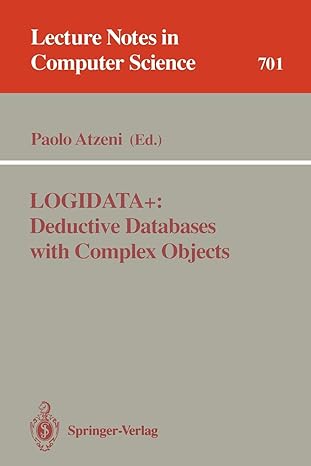Question
This is java WordNet is a semantic lexicon for the English language that computational linguists and cognitive scientists use extensively. For example, WordNet was a
This is java
WordNet is a semantic lexicon for the English language that computational linguists and cognitive scientists use extensively. For example, WordNet was a key component in IBM's Jeopardy-playing Watson computer system. WordNet groups words into sets of synonyms called synsets. For example, { AND circuit, AND gate} is a synset that represent a logical gate that fires only when all of its inputs fire. WordNet also describes semantic relationships between synsets. One such relationship is the is-a relationship, which connects a hyponym (more specific synset) to a hypernym (more general synset). For example, the synset { gate, logic gate } is a hypernym of { AND circuit, AND gate } because an AND gate is a kind of logic gate.
The WordNet digraph. Your first task is to build the WordNet digraph: each vertex v is an integer that represents a synset, and each directed edge vw represents that w is a hypernym of v. The WordNet digraph is a rooted DAG: it is acyclic and has one vertex (the root) that is an ancestor of every other vertex. However, it is not necessarily a tree because a synset can have more than one hypernym. A small subgraph of the WordNet digraph appears below.
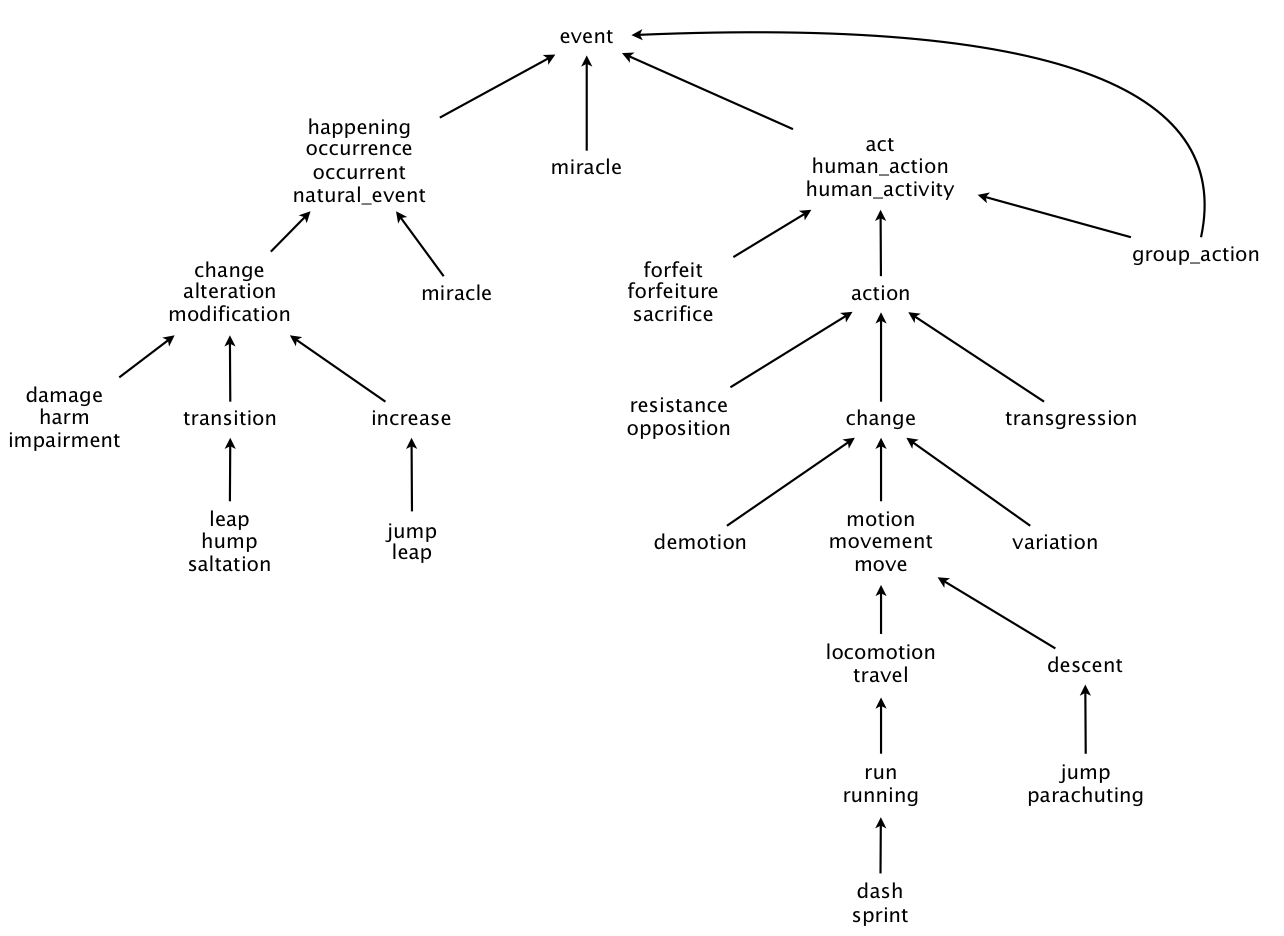
The WordNet input file formats. We now describe the two data files that you will use to create the WordNet digraph. The files are in comma-separated values (CSV) format: each line contains a sequence of fields, separated by commas.
List of synsets. The file synsets.txt contains all noun synsets in WordNet, one per line. Line i of the file (counting from 0) contains the information for synset i. The first field is the synset id, which is always the integer i; the second field is the synonym set (or synset); and the third field is its dictionary definition (or gloss), which is not relevant to this assignment.
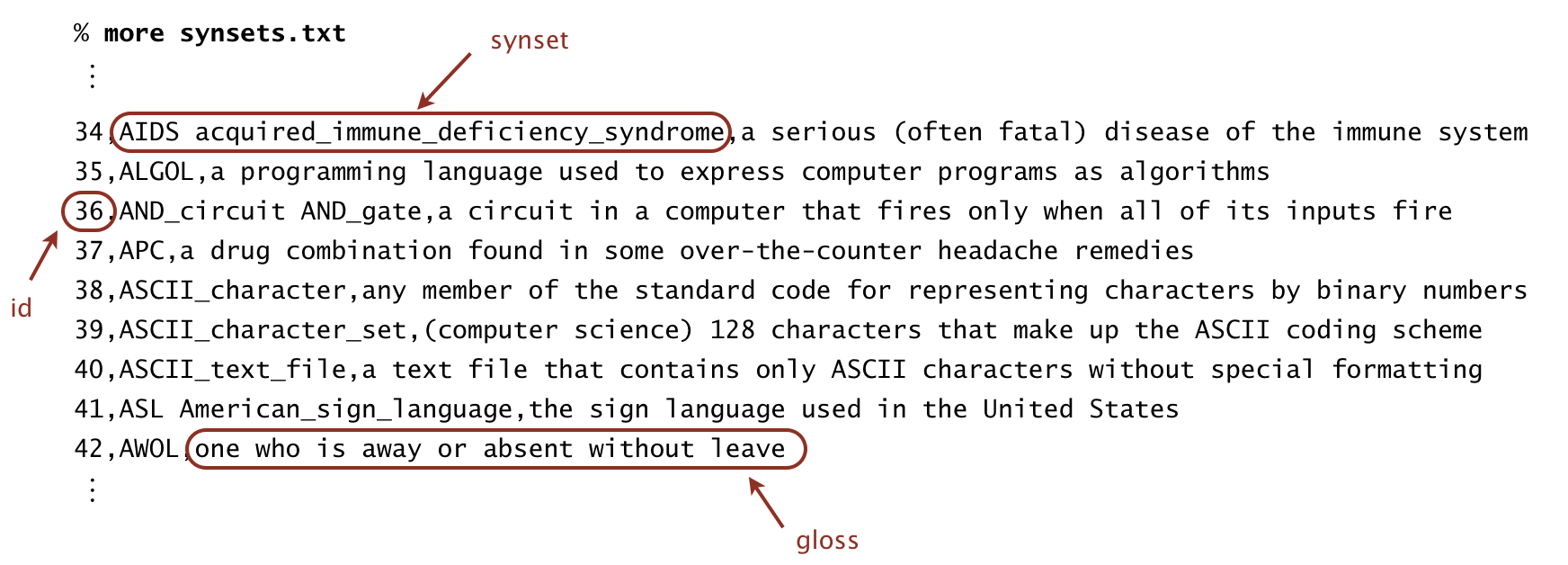
For example, line 36 means that the synset { AND_circuit, AND_gate } has an id number of 36 and its gloss is a circuit in a computer that fires only when all of its inputs fire. The individual nouns that constitute a synset are separated by spaces. If a noun contains more than one word, the underscore character connects the words (and not the space character).List of hypernyms. The file hypernyms.txt contains the hypernym relationships. Line i of the file (counting from 0) contains the hypernyms of synset i. The first field is the synset id, which is always the integer i; subsequent fields are the id numbers of the synset's hypernyms.
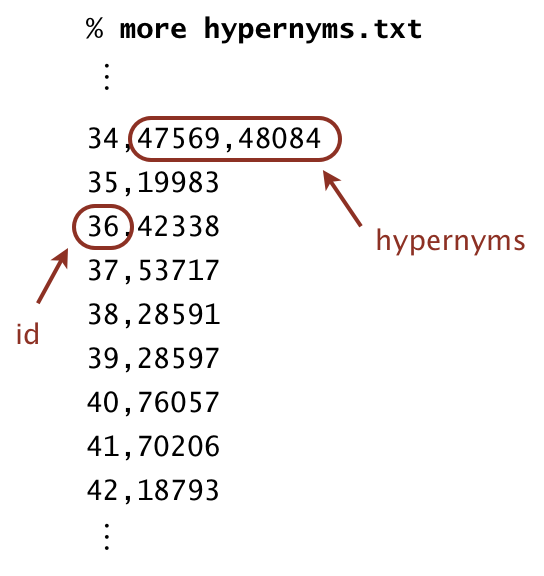
For example, line 36 means that synset 36 (AND_circuit AND_Gate) has 42338 (gate logic_gate) as its only hypernym. Line 34 means that synset 34 (AIDS acquired_immune_deficiency_syndrome) has two hypernyms: 47569 (immunodeficiency) and 56099 (infectious_disease).
WordNet data type. Implement an immutable data type WordNet with the following API:
public class WordNet { // constructor takes the name of the two input files public WordNet(String synsets, String hypernyms) // all WordNet nouns public Iterable nouns() // is the word a WordNet noun? public boolean isNoun(String word) // a synset (second field of synsets.txt) that is a shortest common ancestor // of noun1 and noun2 (defined below) public String sca(String noun1, String noun2) // distance between noun1 and noun2 (defined below) public int distance(String noun1, String noun2) // do unit testing of this class public static void main(String[] args) } Corner cases. All methods and the constructor should throw a java.lang.NullPointerException if any argument is null. The distance() and sca() methods should throw a java.lang.IllegalArgumentException unless both of the noun arguments are WordNet nouns. You may assume that the input files are in the specified format (and that the underlying digraph is a rooted DAG).
Performance requirements. Your data type should use space linear in the input size (size of synsets and hypernyms files). The constructor should take time linearithmic (or better) in the input size. The method isNoun() should run in time logarithmic (or better) in the number of nouns. The methods distance() and sca() should make exactly one call to the length() and ancestor() methods in ShortestCommonAncestor, respectively. For the analysis, assume that the number of characters in a noun or synset is bounded by a constant.
Shortest common ancestor. An ancestral path between two vertices v and w in a rooted DAG is a directed path from v to a common ancestor x, together with a directed path from w to the same ancestor x. Ashortest ancestral path is an ancestral path of minimum total length. We refer to the common ancestor in a shortest ancestral path as a shortest common ancestor. Note that a shortest common ancestor always exists because the root is an ancestor of every vertex. Note also that an ancestral path is a path, but not a directed path.
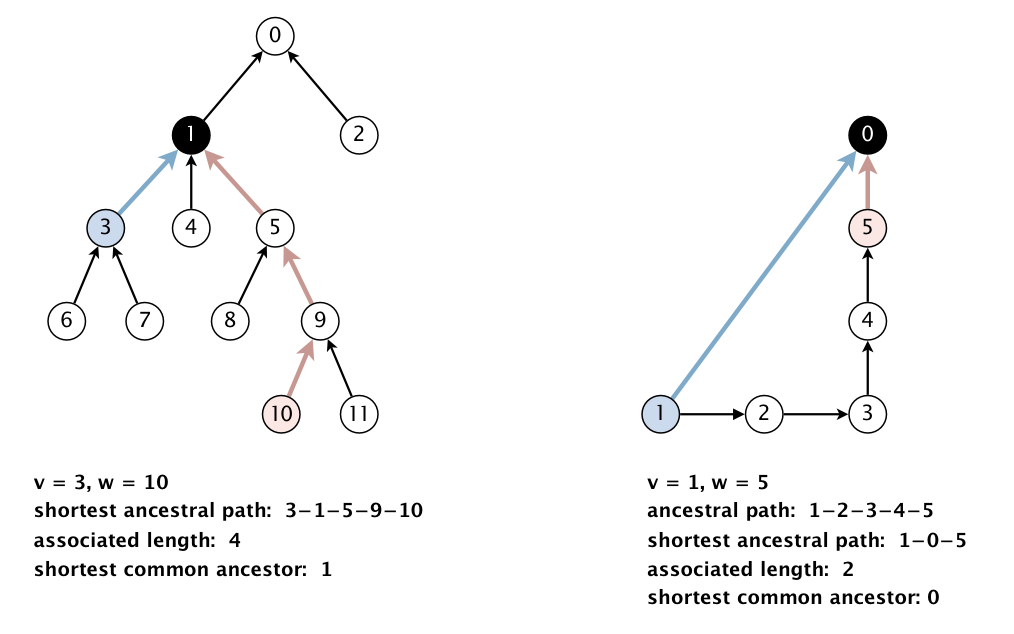
We generalize the notion of shortest common ancestor to subsets of vertices. A shortest ancestral path of two subsets of vertices A and B is a shortest ancestral path over all pairs of vertices v and w, with v in Aand w in B.
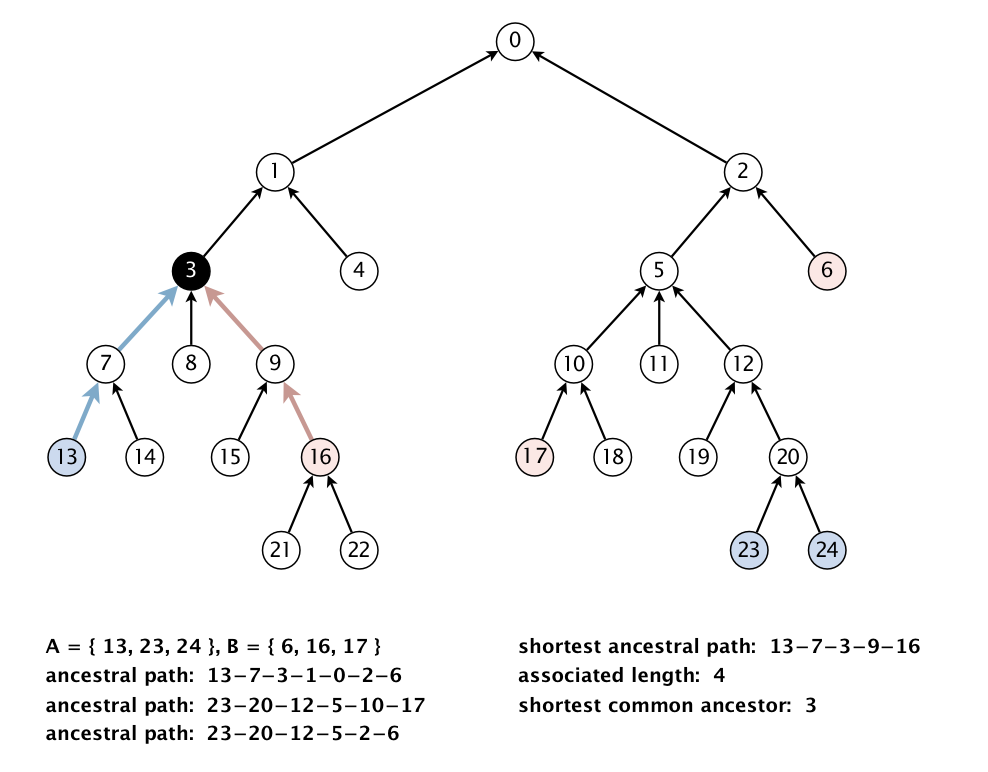
Shortest common ancestor data type. Implement an immutable data type ShortestCommonAncestor with the following API:
public class ShortestCommonAncestor { // constructor takes a rooted DAG as argument public ShortestCommonAncestor(Digraph G) // length of shortest ancestral path between v and w public int length(int v, int w) // a shortest common ancestor of vertices v and w public int ancestor(int v, int w) // length of shortest ancestral path of vertex subsets A and B public int length(Iterable subsetA, Iterable subsetB) // a shortest common ancestor of vertex subsets A and B public int ancestor(Iterable subsetA, Iterable subsetB) // do unit testing of this class public static void main(String[] args) } Corner cases. All methods and the constructor should throw a java.lang.NullPointerException if any argument is null or if any iterable argument contains a null item. The constructor should throw a java.lang.IllegalArgumentException if the digraph is not a rooted DAG. The methods length() and ancestor() should throw a java.lang.IndexOutOfBoundsExceptionif any argument vertex is invalid and a java.lang.IllegalArgumentException if any iterable argument contains zero vertices.
Basic performance requirements. Your data type should use space proportional to E + V, where E and V are the number of edges and vertices in the digraph, respectively. All methods and the constructor should take time proportional to E + V (or better). You will receive most of the credit for meeting these basic requirements.
Additional performance requirements. For full credit, in addition, the methods length() and ancestor() should take time proportional to the number of vertices and edges reachable from the argument vertices (or better). For example, to compute the shortest common ancestor of v and w in the digraph below, your algorithm can examine only the highlighted vertices and edges and it cannot initialize any vertex-indexed arrays (initializing an array of size V takes O(V) time ... but you aren't allowed to take that much time in a call to
ancestor ).
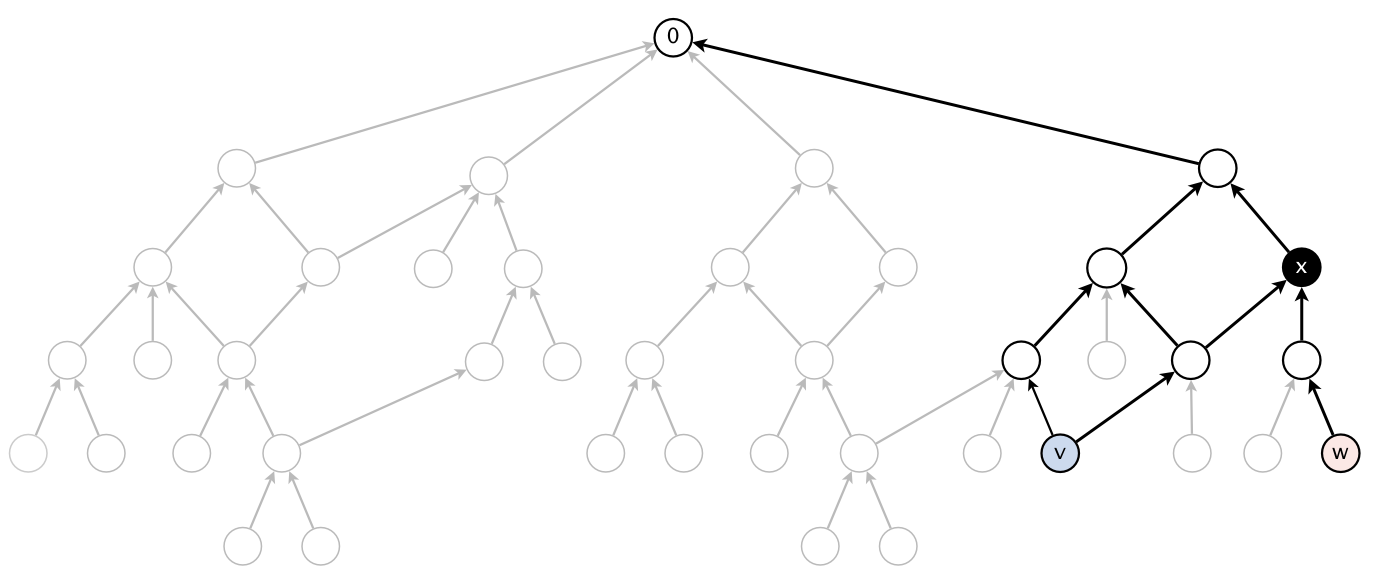
Test client. The following test client takes the name of a digraph input file as as a command-line argument, creates the digraph, reads in vertex pairs from standard input, and prints the length of the shortest ancestral path between the two vertices along with a shortest common ancestor:
public static void main(String[] args) { In in = new In(args[0]); Digraph G = new Digraph(in); ShortestCommonAncestor sca = new ShortestCommonAncestor(G); while (!StdIn.isEmpty()) { int v = StdIn.readInt(); int w = StdIn.readInt(); int length = sca.length(v, w); int ancestor = sca.ancestor(v, w); StdOut.printf("length = %d, ancestor = %d ", length, ancestor); } } Here is a sample execution (the bold indicates what you type):
% more digraph1.txt % java ShortestCommonAncestor digraph1.txt 12 3 10 11 length = 4, ancestor = 1 6 3 7 3 8 11 3 1 length = 3, ancestor = 5 4 1 5 1 6 2 8 5 length = 4, ancestor = 0 9 5 10 9 11 9 1 0 2 0
Measuring the semantic relatedness of two nouns. Semantic relatedness refers to the degree to which two concepts are related. Measuring semantic relatedness is a challenging problem. For example, you consider George W. Bush and John F. Kennedy (two U.S. presidents) to be more closely related than George W. Bush and lion (two mammals). It might not be clear whether W.C. Fields and Eric Arthur Blair are more related than two arbitrary people. However, both W.C. Fields and Eric Arthur Blair (aka George Orwell) are famous communicators and, therefore, closely related.
We define the semantic relatedness of two WordNet nouns x and y as follows:
A = set of synsets in which x appears
B = set of synsets in which y appears
distance(x, y) = length of shortest ancestral path of subsets A and B
sca(x, y) = a shortest common ancestor of subsets A and B
This is the notion of distance that you will use to implement the distance() and sca() methods in the WordNet data type.

Outcast detection. Given a list of WordNet nouns x1, x2, ..., xn, which noun is the least related to the others? To identify an outcast, compute the sum of the distances between each noun and every other one:
di = distance(xi, x1) + distance(xi, x2) + ... + distance(xi, xn)
and return a noun xt for which dt is maximum. Note that because distance(xi, xi) = 0, it will not contribute to the sum.
Implement an immutable data type Outcast with the following API:
public class Outcast { public Outcast(WordNet wordnet) // constructor takes a WordNet object public String outcast(String[] nouns) // given an array of WordNet nouns, return an outcast public static void main(String[] args) // see test client below } Assume that argument to outcast() contains only valid WordNet nouns (and that it contains at least two such nouns).
The following test client takes from the command line the name of a synset file, the name of a hypernym file, followed by the names of outcast files, and prints out an outcast in each file:
public static void main(String[] args) { WordNet wordnet = new WordNet(args[0], args[1]); Outcast outcast = new Outcast(wordnet); for (int t = 2; t Here is a sample execution:
% more outcast5.txt horse zebra cat bear table % more outcast8.txt water soda bed orange_juice milk apple_juice tea coffee % more outcast11.txt apple pear peach banana lime lemon blueberry strawberry mango watermelon potato % java Outcast synsets.txt hypernyms.txt outcast5.txt outcast8.txt outcast11.txt outcast5.txt: table outcast8.txt: bed outcast11.txt: potato
Analysis of running time. Analyze the potential effectiveness of your approach to this problem by answering the questions below:
What is the order of growth of the worst-case running time of the length() and ancestor() methods in ShortestCommonAncestor?
What is the order of growth of the best-case running time of of the length() and ancestor() methods in ShortestCommonAncestor?
Your answers should be given as a function of the number of vertices V and the number of edges E in the digraph.
event nappening occurrence occurrent natural event act human action human_activity miracle group_action change alteration modification forfeit forfeiture sacrifice miracle action damage harm impairment resistance opposition transition increase change transgression leap hump saltation jump leap motion movement move demotion variation locomotion travel descent jump parachuting run runnin dash sprint event nappening occurrence occurrent natural event act human action human_activity miracle group_action change alteration modification forfeit forfeiture sacrifice miracle action damage harm impairment resistance opposition transition increase change transgression leap hump saltation jump leap motion movement move demotion variation locomotion travel descent jump parachuting run runnin dash sprint Step by Step Solution
There are 3 Steps involved in it
Step: 1

Get Instant Access to Expert-Tailored Solutions
See step-by-step solutions with expert insights and AI powered tools for academic success
Step: 2

Step: 3

Ace Your Homework with AI
Get the answers you need in no time with our AI-driven, step-by-step assistance
Get Started


